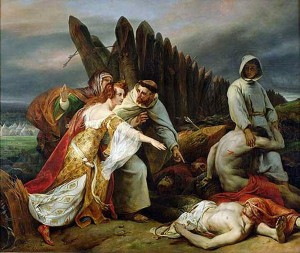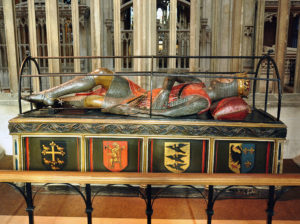
The fate of Ulf is of great interest to the Norwood family who claim descent from Harold through him. The researches of Marian Callum Norwood, the noted genealogist and family historian who did much to develop the histories of the various branches of the family, is the source of these claims. In the many years since Marion’s death however, others who have followed her work more critically have taken issue with the absence of a credible connection between Jordanus of Sheppey, the 12th century patriarch of the family from whom the Norwood clan indubitably descended and Alnod Cilt or Ulf, the son of Harold.
Ulf was seized after Hastings (where he was too young to fight) and confined in Normandy. But later, like Wulfnoth, the youngest brother of Harold, he was released by William on his deathbed, reportedly at the urging of the church, as an act of mercy. The record shows that William’s estranged son, Robert Curthose, the next Duke of Normandy took a shine to Ulf and knighted him not long after.
It is inconceivable that Ulf would not have remained close to his benefactor and fought with him during the many actions that troubled Normandy from the rivalry between Robert and his siblings, William Rufus and Henry and the activities of other unruly knights. It is equally improbable that Ulf did not accompany him as a mature warrior when he went on the Crusade. This service would have been the most evident route towards reacquiring and retaining his ancestral lands, the defense of which was an inherent element in the knight’s role.
Ulf’s aspirations to land were associated with Kent, so after his formal release in 1087, and after his belting as a knight, he is likely to have sought restoration. By this time, his Anglo-Saxon identity would have been transformed by 20 years of Norman tutelage. It is clear from Domesday that Anod/Cilt/Ulf once had major manorial holdings in Kent which overlap with the later location of the Jordanus/Norwood family properties. This link is said to consolidate the supposed connection. Alnod’s former lands are well laid out from Domesday in Marion’s third book and cover widespread manors in Alnod’s name from Rochester to Dover, embracing Canterbury, Whitstable, Sheppey, Thanet, Norwood, Chart Sutton and many more. These had been held by Alnod /Ulf from King Edward, presumably from childhood, but were subordinated to the feudal over-lordship of Odo of Bayeux, William’s half-brother and the Church after the Conquest. Marian asserts that Alnod recovered some of these and that they continued in the possession of Jordanus of Sheppey and the Norwoods for 300 years.
There is no complete record of the knights who served Robert and who participated in the First Crusade which was known to be hazardous but Pope Urban had said that “by the will of God, he absolved all penitents from their sins from the moment that they took the cross of Christ”, which produced a surge of participants. Around 60,000 soldiers took part in the Crusade of which around 6,000 were knights and a further 30,000 provided support. This is not the place to detail the history of the Crusade but the crowning moment for Robert was in August 1099 when after victory in Jerusalem, the crusaders were confronted by an Egyptian Fatimid army at Ascalon, southwest of Jerusalem. Robert commanded the centre division of the Crusader Army and charging at the heart of the Egyptian camp, personally captured the Vizier’s banner and his tent. The Emir fled and was lucky to escape, leading to a great victory for which Robert’s part was much celebrated. After the battle and before beginning the return home, Robert completed his pilgrimage by immersing himself in the River Jordan. It was this act which encouraged crusaders to give themselves the soubriquet “Jordanus”, the title held by the founder of the Norwood family.

The obvious conclusions that one draw might from this story is that Ulf after his release from nominal confinement in Normandy, receiving his knighthood and giving service to Robert, was able to claim back at least some his lands. His 20 or so years in Normandy had “Normanized“ him. Ulf would have been at least around 40 and possibly older when he challenged for the return of his land. His most likely date of birth is around and possibly before 1050. As Harold’s older sons, starting with Godwine were of an age to contest the throne, post Conquest, it must be assumed that the hand fast marriage with Edith took place in the 1040s with children appearing at regular intervals. This would have made Ulf 16 at the Conquest, 37 upon his release by William in 1087 and in his late forties during the First Crusade. What appears to be clear and is suggested by a number of references in Domesday is that Alnod/Ulf successfully reclaimed land that we know is associated with the subsequent Northwode aka Norwood holdings.
Ulf would have been at least around 40 and possibly older when he challenged for the return of his land after the Penenden Heath trial. His most likely date of birth is around and possibly before 1050. As Harold’s older sons, starting with Godwine were of an age to contest the throne, post Conquest, it must be assumed that the hand fast marriage with Edith took place in the 1040s with children appearing at regular intervals. This would have made Ulf 16 at the Conquest, 37 upon his release by William in 1087 and in his late forties during the First Crusade. What appears to be clear and is suggested by a number of references in Domesday is that Alnod/Ulf successfully reclaimed land that we know is associated with the subsequent Northwode holdings. Marion says that Alnod/Ulf had held 20 manors but at the Domesday Survey, none, as almost half had been conveyed to Odo of Bayeux. At Penenden Heath, Alnod’s name is cited as a recent subtenant of Manors which Odo had assumed. The thesis is that on his release and rehabilitation by Robert Curthose, Ulf seized back two parts of Kings Wood on Sheppey which he was allowed to keep not by feudal but by costumal tenure, which effectively recognized the earlier status of his ownership. The source for this is Henry Bracton (c.1210–c.1268) an English cleric and jurist. These properties were also held by gavelkind, which means that they were sellable and not just held in fealty to an Earl. It is not clear which other properties Ulf recovered.
Notwithstanding these credible assertions, it is most unlikely on the face of it that Ulf was the father of Jordanus of Sheppey, as the latter was born in 1135 making Ulf around 85 at the time of his conception. This is not impossible but it is improbable. However, there is a possibility of a link between Ulf and Jordanus if we postulate that the honorific title acquired by Ulf after Ascalon passed to Jordanus of Sheppey though a third person. As some commentators have suggested, Jordanus could be the grandson of Ulf through an illegitimate or unrecognised son.
Some Norwood online trees trace their genealogy directly back to Jordanus de Sheppey, and then to Harold Godwineson as his father, basing this on Marion Norwood Callum’s researches – that cannot be true. The chronology does not hold; court documents for Jordan’s wife and children make it clear that he had to have been born long after Harold Godwinson was dead at Hastings, indeed in 1135.
Finally, there is the intriguing reference to Loup Fitz Heraut (Wulf son of Harold). It is regrettable that more is not known about this knight. An area worthy of research.